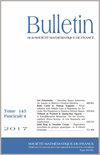Phasmatodea of Jamaica, part II: a new genus of the Diapheromerini tribe (Phasmatodea, Occidophasmata, Diapheromeridae)
IF 0.6
4区 数学
Q3 MATHEMATICS
引用次数: 0
Abstract
A new genus of stick insect from Jamaica is described, Jamanistria n. gen., which includes three species previously assigned to the genus Clonistria Stål, 1875, and one new species discovered by the authors in 2018, J. xerophila n. sp., described in both sexes and the egg. The previously unknown female and egg of Jamanistria annulipes (Rehn & Hebard, 1938) n. comb., male and egg of J. simplicitarsis (Gray, 1835) n. comb., female and egg of J. monticola (Rehn & Hebard, 1938) n. comb. are described here for the first time. A barcoding study based on COI gene of three species of the genus is presented and supports the species delimitations.牙买加Phasmatodea (II): Diapheromerini部落一新属(Phasmatodea, Occidophasmata, Diapheromeridae)
描述了牙买加竹节虫的一个新属Jamanistria n. gen.,其中包括1875年以前归属于Clonistria st属的三个物种,以及作者在2018年发现的一个新物种J. xerophila n. sp.,两性和卵都有描述。以前不为人知的annulipes jamanistaria的雌和卵(Rehn & Hebard, 1938) n. comb。(Gray, 1835) n.梳子。J. monticola (Rehn & Hebard, 1938) n.梳子。都是第一次在这里描述。提出了一种基于COI基因的条形码研究,支持了种界的划分。
本文章由计算机程序翻译,如有差异,请以英文原文为准。
求助全文
约1分钟内获得全文
求助全文
来源期刊
CiteScore
0.90
自引率
0.00%
发文量
0
审稿时长
>12 weeks
期刊介绍:
The Bulletin de la Société Mathématique de France was founded in 1873, and it has published works by some of the most prestigious mathematicians, including for example H. Poincaré, E. Borel, E. Cartan, A. Grothendieck and J. Leray. It continues to be a journal of the highest mathematical quality, using a rigorous refereeing process, as well as a discerning selection procedure. Its editorial board members have diverse specializations in mathematics, ensuring that articles in all areas of mathematics are considered. Promising work by young authors is encouraged.

 求助内容:
求助内容: 应助结果提醒方式:
应助结果提醒方式:


